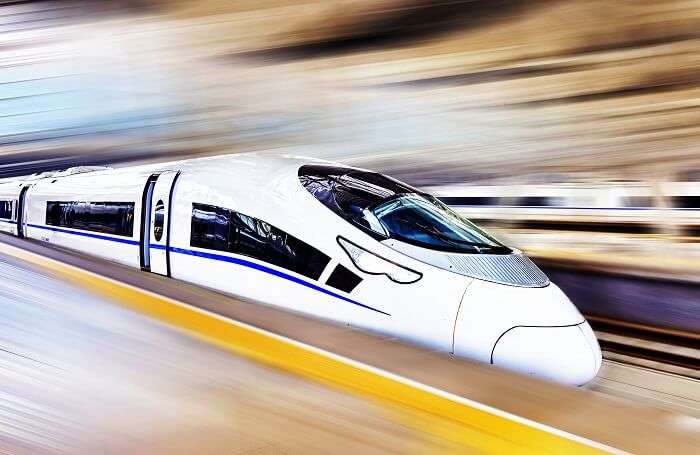High Speed Trains: Redefining The Future Of Travel With A Fast And Furious Technology!

Time is money, time is precious, and time is a treasure especially when you are traveling. And if a mode of transportation is fast enough to cut down on that while traveling, it’s a blessing in disguise. Not only it buys you extra time to explore more but also to live more, and experience more on a vacation.
Likewise, high speed trains have been gaining fame off-lately amidst the travelers. Competing with the leading airlines on the main and most-frequented routes across Europe and Asia, here’s why high speed trains are considered to be the future of travel.
About The Technology Of High Speed Trains
According to the Journal of Advanced Transportation, the academic research states that travelers opt for high speed trains and planes when the distance of their journey surpasses the 1000-kilometer milestone. While referring to the works of few other researchers from the University of South Florida in Tampa and Beihang University in Beijing, it is observed that travel time in particular happens to be a critical metric for measuring the competitiveness of various modes of transportation.

Suggested Read: 7 Super Luxury Trains In India That Are Worth Spending A Fortune In 2022
In simple words, people try to save time when it comes to long journeys, and hence, end up opting for flights most of the times. However, the new technology introduced via high speed trains has brought groundbreaking revolution that may change the face of long-distance traveling in future.
The Inception Of High Speed Trains

It doesn’t come as a surprise that the concept of high speed trains was introduced by China in Shanghai with their first ever Maglev train that travels at a speed of 430 kph. While the engineers in China continue to brainstorm about a 600 kph Maglev trains, it was observed that around 910 million of Chinese population commuted via trains which is more than the double of about 415 million who took flights in the year of 2015. This is what gave the much needed boost to the high speed trains.
How Are High Speed Trains Cost-Effective?
Not just in Europe and Asia, but the rise of high speed trains in other countries such as China, South Korea, and Japan also gave rise to some of the preconceptions as to how railways and airways can compete.

Suggested Read: China Begins Operation Of World’s First Trackless Train, And Redefines Urban Travel
One of the renowned Assistant Professor of Civil and Environmental Engineering at the University of South Florida named Yu Zhang has it in opinion that over a period of time, high speed trains and airlines in China have evolved so much while competing that their quality of services and the cost of traveling have eventually become comparable.
Clearly, it was not the case earlier. In order to equate their services to that of the airlines, the high speed train operators in China looked forward to compete with the leading airlines with fares that were way too high. But with time, that scenario has changed too as the rates of train tickets have dropped immensely.

While the distance of the route taken by the passengers and the availability of seats still play a crucial role in choosing one mode over the other, Professor Yu Zhang also stated that there has been an impact on the airlines in terms of frequency and fares. Nonetheless, there has been no drop in the number of passengers traveling by air.
For example, when the famous Eurostar began its services from London to Brussels and Paris, the charges were 79 pounds and only 2.9 million people traveled by train back in 1994. Comparatively, the prices have dropped to 29 pounds while the number of passengers increased up to 10 million.
What Are The Benefits Of High Speed Trains?
It is not always necessary for a new entrant like that of high speed trains to impact the existing market of airlines which has been dominating in nature ever since its inception. While the services of high speed trains have created a buzz in the key markets for sure along with the rising demand, it has only benefited the travelers as the low-cost airlines across Europe, America, and Asia have revised their fares too.

Suggested Read: Trans Siberian Railway: World’s Longest Rail Network That Crosses 8 Time Zones Across 9300 Kms!
In short, it has not only been beneficial for the airlines and trains, but also for the travelers to a great extent. Some of the general and environmental benefits are:
- Travelers have witnessed a dip in the fares which is a good sign.
- Time of traveling has comparatively been cut down too.
- More high speed trains means less burning of the jet fuel which facilitates a good natural environment.
- Availability of more options for the long-distance travelers.
- Most importantly, traveling on the surface is much more safer than flying in the air.
Which Are The World’s Fast And The Furious Trains?
Unfortunately, America doesn’t make it in the list of top high speed trains as the country is dominated by automobiles more than the locomotives. The fastest that the American Acela train can run is that of 241 kph which in reality doesn’t exceed 161 kph too. However, from Shanghai to Beijing, and from Paris to Japan, here are some of the high speed trains in Asia and Europe that are changing the face of the travel in future.

- Maglev Train in Shanghai China – 430 kph
- Fuxing Train in Beijing China – 351 kph
- Shinkansen Train in Japan – 320 kph
- TGV Train in Paris – 320 kph
- Eurostar Train in Europe – 300 kph
In short, though the airlines might have got impacted by the entry of high speed trains in the key markets of Asia and Europe, the services have only proven to be beneficiary as the number of commuters on the leading routes have only increased with time. And as a result, the low-cost airlines have started functioning between the two-tier cities as well which results in more connectivity.
Hence, chances are high that these high speed trains can be the future of travel across Asia, Europe, and hopefully, one day in India as well. Also, do let us know your opinion whether you’d like one of these high speed trains to function in India, in the comments below!

An empty vessel in Christ’s hands. Rest we can talk over chai. :)











